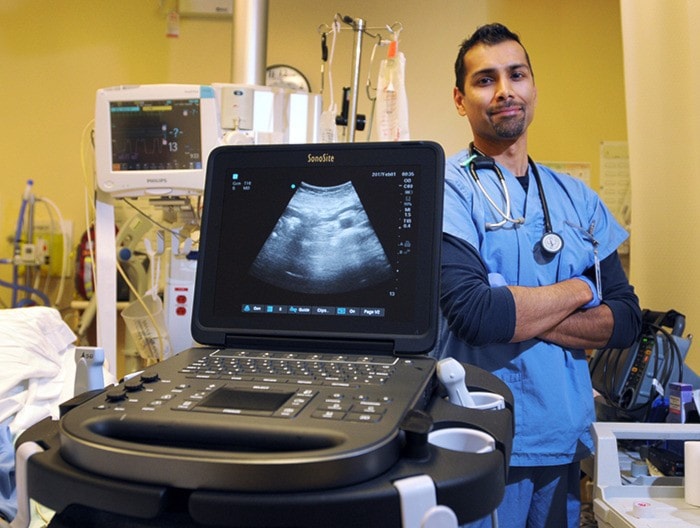The archetypal image of a doctor is a person with a stethoscope around his or her neck, but that old cliche needs an update.
“Ultrasound is the new stethoscope,” said Dr. Ravi Rughani, a full-time dedicated emergency doctor at Ridge Meadows Hospital.
He said the emergency ward recently was recently given “the Mercedes of ultrasound machines,” the first to be purchased for a Canadian hospital.
For most patients, their first and only experience with an ultrasound machine is when they are expecting a child. Using technology that was originally developed to find German U-boats during the First World War, most parents saw their unborn baby in a pixilated black and white image on a monitor.
With the hospital’s new machine, you can tell whether the baby is smiling or frowning.
But it’s in emergency, and there are numerous applications.
Rughani described a shift in which he used the portable bedside ultrasound, taking it from patient to patient.
In one, he found a blood clot.
In another person, who was in extreme abdominal pain, he looked into their gallbladder to see whether they were suffering from gallstones.
He explained that being able to rule out that potential health problem in one or two minutes saved tests that would take much longer.
“A whole rigmarole.”
And for another patient who had a foreign body under the skin – a piece of metal from a skateboard – he used the ultrasound to quickly locate and “fish out” a chunk of steel that could otherwise be “notoriously difficult to find.”
The new ultrasound machine was purchased through the fundraising efforts of the Ridge Meadows Hospital Foundation for$70,000.
Rughani said it not only makes ER doctors more efficient in their work, but is a critical tool in diagnosing serious health conditions.
In acute situations, where time is limited and quick decisions need to be made, a doctor can examine a trauma patient to detect bleeding around the heart, lungs or in the abdomen. This can be difficult to do with traditional clinical skills, and at times it required patients to be brought directly to the operating room.
The ultrasound can quickly diagnose an ectopic pregnancy, which is prone to rupturing and is a life-threatening condition. Rughani said these are found on a regular basis – every few months – at Ridge Meadows Hospital.
It can evaluate the degree of septic shock (blood infection), which can cause death in a matter of hours.
In non-acute situations, ultrasound helps doctors safely perform procedures such as putting large IVs in the neck or groin veins and setting fractures, and to evaluate a host of medical conditions, from retinal detachments to confirming pregnancy.
Rughani said using ultrasound outside of the traditional radiology department makes sense, especially with acute patients who “you literally have to watch second by second.
“Ultrasound has exploded over the last decade,” he said.
Ten years ago, about 20 per cent of emergency room staff would be trained in ultrasound, but now everyone is up to speed, he said.
“When the hospital foundation came through, yet again, with funds to purchase a new machine, we wanted to make sure we were getting the most cutting edge technology, so we bought the Sonosite Edge 2,” he said.
It is billed as the leader in point of care ultrasound (pocus, in medical terms).
He explained the new machine basically allows doctors to see deeper into the body and with better resolution.
It’s like watching a HD TV compared with the old cathode ray tube models.
It is also streamlined and fits in tight spaces, which is important when more than one person is tending to patient, is built to be exceptionally durable, and has a unique docking station to keep the machine fully charged.
Rughani said that is a common and annoying issue with other machines, which often die during prolonged use, and doctors are forced to find a socket and recharge.
“We are really thankful to have it,” Rughani added. “It makes a big difference – especially with the really sick patients.”
